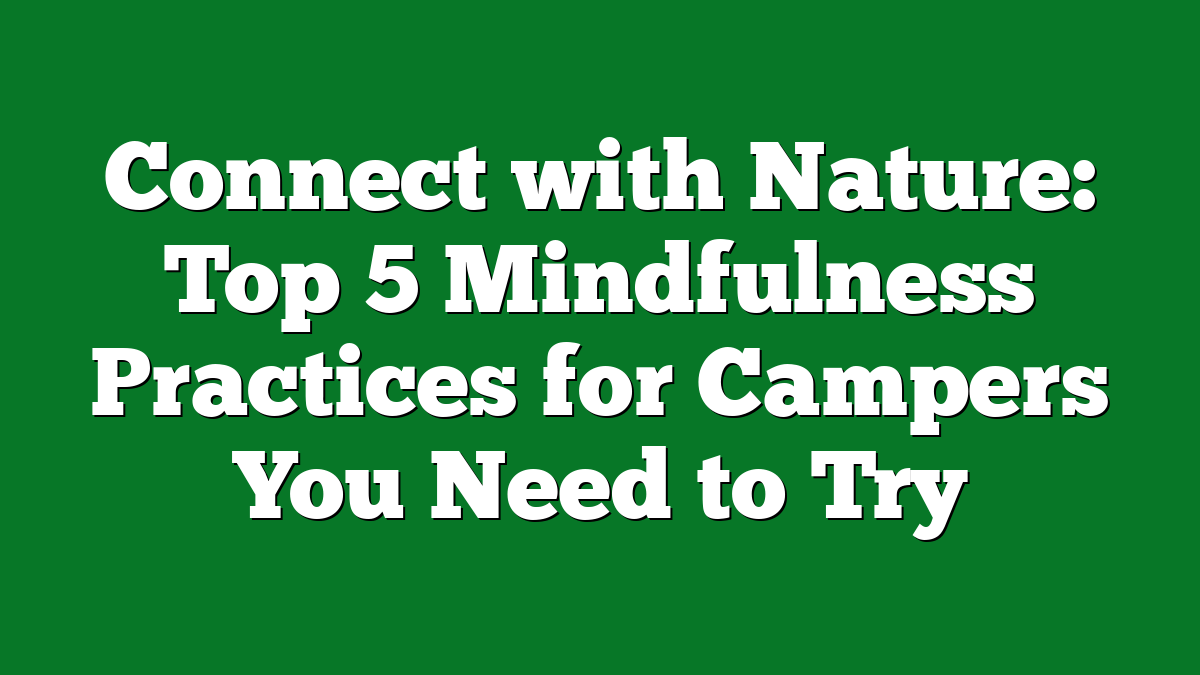Camping is one of my favorite ways to escape the hustle and bustle of everyday life. There’s something magical about being surrounded by nature that invites us to slow down and truly connect with our surroundings. But have you ever thought about how mindfulness can enhance your camping experience?
Incorporating mindfulness practices while camping can deepen your appreciation for the great outdoors and help you find peace in the moment. Whether you’re roasting marshmallows by the fire or hiking through a serene forest, these practices can transform your time in nature into a truly enriching adventure. Let’s explore the top five mindfulness practices that can elevate your camping trips and help you reconnect with yourself and the world around you.
Top 5 Mindfulness Practices for Campers
- Nature Walks
Nature walks immerse me in the environment. Every step brings the sounds of rustling leaves and bird calls into focus. I pause to observe the intricate patterns of bark on trees and the way sunlight filters through branches. This practice enhances my connection with nature.
- Breath Awareness
Breath awareness centers me amidst the wilderness. I sit quietly, close my eyes, and focus on my breathing. Inhaling deeply through my nose and exhaling slowly through my mouth calms my mind. This simple practice grounds me in the present moment.
- Gratitude Journaling
Gratitude journaling invites reflection on my camping experiences. I write down what I appreciate about the sights and sounds around me, whether it’s the beauty of the sunrise or the taste of a freshly caught fish. This practice fosters a sense of contentment during my trips.
- Mindful Eating
Mindful eating transforms meals into conscious experiences. Instead of rushing through dinner, I savor each bite of my meal. I focus on the flavors and textures, relishing the nourishment the outdoors provides. This habit enhances my enjoyment of food and fuels my adventures.
- Stargazing
Stargazing invites awe and wonder into my camping routine. At night, I lay back, gaze at the stars, and contemplate my place in the universe. I track constellations and marvel at the vastness above. This practice deepens my appreciation for the simplicity and beauty of the outdoors.
Practice 1: Nature Meditation
Nature meditation brings an opportunity to immerse oneself in the serene beauty of the outdoors. This practice enhances my camping experience, allowing me to connect deeply with the environment.
Benefits of Nature Meditation
- Stress Reduction: Nature meditation effectively reduces stress levels. Spending time in natural surroundings calms the mind, decreasing anxiety.
- Enhanced Focus: Meditating in nature sharpens my focus. It clears distractions, which boosts concentration on the moment and surroundings.
- Greater Connection to Nature: This practice fosters a deeper connection to the wilderness. It heightens awareness of the sights, sounds, and sensations of the natural world.
- Improved Well-Being: Regular nature meditation promotes overall well-being. It enhances emotional health, leading to greater happiness and life satisfaction.
- Increased Mindfulness: Sitting quietly in nature increases mindfulness. It cultivates a present-focused mindset, enriching the overall camping experience.
Tips for Getting Started
- Find a Quiet Spot: Locate a peaceful area away from noise and distractions. I’m often drawn to a secluded spot by a stream or under a tall tree.
- Sit Comfortably: Choose a comfortable position, whether sitting or lying down. Ensure my posture encourages relaxation without drifting off.
- Focus on Breath: Center attention on breathing. Inhale deeply through the nose, then exhale slowly through the mouth. This practice grounds me in the moment.
- Observe Surroundings: Pay attention to the sounds and sights around. Listen to bird calls, feel the breeze, and watch the leaves dance.
- Set a Timer: Start with short sessions, around 5 to 10 minutes. Gradually extend the duration as comfort with the practice grows.
Incorporating nature meditation into camping enriches my time outdoors, bringing peace and clarity amidst the beauty of the wild.
Practice 2: Mindful Hiking
Mindful hiking deepens my connection to nature and enhances my outdoor experience. This practice allows me to fully immerse myself in the beauty around me while staying present during each step of my journey.
Techniques for Mindful Hiking
- Slow Down: I concentrate on slowing my pace. Moving deliberately allows me to observe details like the rustling leaves, the scent of pine, or the sound of a nearby stream.
- Observe Your Surroundings: I focus my attention on the environment. I take note of the colors, textures, and shapes of plants, rocks, and wildlife. This heightened awareness brings the trail to life.
- Engage Your Senses: I pay attention to all my senses. I listen to the wind, feel the temperature, and breathe in the fresh air. This sensory engagement anchors me in the present moment.
- Walking Meditation: I sometimes incorporate walking meditation. I synchronize my steps with my breath, inhaling deeply with each step and exhaling slowly. This rhythmic pattern calms my mind and enhances my focus.
- Let Go of Distractions: I leave behind any lingering worries or distractions. Focusing on the path ahead helps maintain my connection to nature and fosters a peaceful mindset.
Incorporating Breathing Exercises
I find that integrating breathing exercises during my hike enhances mindfulness. Here are some ways I do this:
- Deep Breaths: When I start my hike, I take a few deep breaths. Inhaling deeply through my nose fills my lungs, and exhaling slowly through my mouth releases tension.
- Counted Breaths: I sometimes count my breaths as I hike. I inhale for four counts, hold for four, and exhale for six. This technique prolongs the exhale and promotes relaxation.
- Nature’s Rhythm: I synchronize my breath with nature’s sounds. Listening to birdsong or rustling leaves helps me attune my breathing to the natural environment around me.
- Focused Breathing Breaks: During breaks, I practice focused breathing. Sitting or standing still, I close my eyes, center my thoughts, and take several minutes to breathe deeply.
- Mindful Exhalation: As I exhale, I visualize my stress dissipating. I feel lighter and more connected to my surroundings, enhancing my overall hiking experience.
These practices of mindful hiking remind me to embrace the journey and appreciate every moment spent outdoors.
Practice 3: Grounding Techniques
Grounding techniques connect me to the present moment and the earth beneath my feet. These practices help me feel centered, especially when surrounded by nature’s beauty.
Understanding Grounding
Grounding, often called earthing, refers to the practice of connecting with the earth’s energy. This connection fosters feelings of stability and calm. When I take a moment to ground myself, I feel more balanced and anchored in my surroundings. Whether it’s standing barefoot on the ground or simply taking a deep breath, these techniques encourage mindfulness, helping me to focus on the sensations around me—the rustle of leaves, the warmth of sunlight, and the sound of wildlife.
Simple Grounding Exercises
- Barefoot Walking: Walking barefoot on natural surfaces—grass, soil, or sand—allows me to feel the earth’s texture. Each step helps me connect with nature.
- Sensory Awareness: I close my eyes and tune into my senses. I notice the sounds of chirping birds, the smell of pine trees, and the sensation of the breeze on my skin. This exercise deepens my appreciation for the surrounding environment.
- Tree Hugging: Leaning against a tree and wrapping my arms around its trunk creates a feeling of connection and support. I visualize drawing energy from the tree, enhancing my sense of grounding.
- Deep Breathing: I take deep breaths, inhaling through my nose and exhaling through my mouth. Focusing on my breath helps clear my mind and reinforces my connection to the moment and the earth.
- Mindful Sitting: Sitting quietly on the ground or a rock, I focus on the sensations of the earth beneath me. I pay attention to how its stability grounds my thoughts and emotions.
Incorporating these grounding techniques enhances my camping experience. They help me stay present, appreciate nature’s beauty, and connect more deeply with the environment.
Practice 4: Gratitude Journaling
Gratitude journaling adds depth to camping experiences by encouraging reflection on the moments in nature that resonate most. I find it a powerful way to connect with my surroundings and appreciate the small joys that each trip offers.
How to Start a Gratitude Journal
Starting a gratitude journal is simple and doesn’t require any fancy materials. Grab a notebook or use your phone—a quick note app works just fine. Set aside a few minutes each evening to jot down three to five things you’re grateful for from your day. Focus on specific moments, like the sound of a crackling campfire, the sight of a breathtaking sunset, or the laughter shared with friends. If you’re feeling inspired, add drawings or sketches of your surroundings. Consistency makes this practice effective, so try to journal every day during your camping trip.
Benefits of Journaling in Nature
Journaling in nature brings numerous benefits. It helps me process my thoughts and emotions, enhancing my mindfulness and appreciation for the beauty around me. Writing outdoors invites fresh air and tranquility, which often leads to greater creativity and clarity. Research indicates that gratitude journaling can improve mood and reduce stress. By reflecting on positive experiences, I nurture a sense of contentment that carries with me long after the trip ends. Plus, reading past entries becomes a joyful reminder of adventures spent in the great outdoors.
Practice 5: Mindful Campfire Rituals
Campfire rituals serve as perfect opportunities to incorporate mindfulness into our camping experiences. As the sun sets and darkness envelops the campsite, gathering around the flickering flames creates an atmosphere ripe for reflection and connection.
Creating a Mindful Campfire Experience
Creating a mindful campfire experience involves focusing on the sights, sounds, and smells that surround the fire. I sit quietly, listening to the crackling wood and the gentle rustle of leaves in the breeze. I take a moment to breathe in the rich scent of burning pine and let it fill my senses. Each breath becomes a reminder of the present, grounding me in the moment. Engaging in activities like toasting marshmallows or preparing food over the fire can also transform into mindful practices. By paying attention to how the flames dance and the way the food changes as it cooks, I deepen my connection to the moment and the outdoors.
Shared Reflections with Fellow Campers
Sharing reflections with fellow campers adds an enriching layer to the campfire experience. I encourage everyone to share their thoughts, stories, or favorite memories of nature. Each person’s perspective brings new insights, enhancing our collective appreciation for the great outdoors. Taking turns speaking while others listen intentionally creates a sense of community. I find that discussing what each experience means fosters stronger bonds and creates lasting memories. Whether it’s sharing gratitude for the day’s adventures or expressing hopes for the coming days, these reflections create a meaningful tapestry of connection, enriching our camping journey together.
Conclusion
Embracing mindfulness while camping has truly transformed my outdoor experiences. Each practice offers a unique way to connect with nature and myself. Whether it’s taking a moment to breathe deeply or jotting down what I’m grateful for, these small shifts make a big difference.
I’ve found that slowing down and being present not only enhances my appreciation for the beauty around me but also fosters a sense of peace I carry back into everyday life. So next time you hit the trails or gather around a campfire, consider incorporating these mindfulness practices. They might just turn your camping trip into a more enriching adventure. Happy camping!











